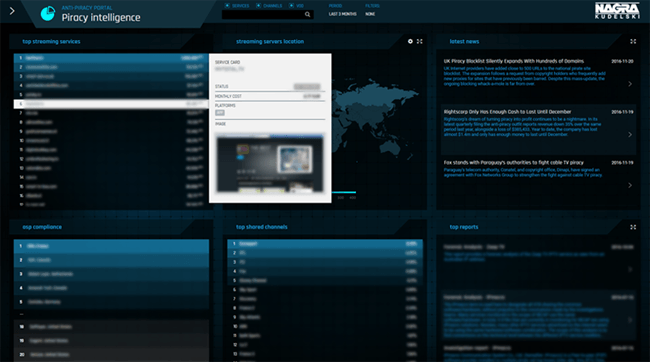 Nagravision or NAGRA is one of the best known companies operating in the digital cable and satellite television content security space. Due to successes spanning several decades, the company has often proven unpopular with pirates.
Nagravision or NAGRA is one of the best known companies operating in the digital cable and satellite television content security space. Due to successes spanning several decades, the company has often proven unpopular with pirates.
In particular, Nagravision encryption systems have regularly been a hot topic for discussion on cable and satellite hacking forums, frustrating those looking to receive pay TV services without paying the high prices associated with them. However, the rise of the Internet is now presenting new challenges.
NAGRA still protects traditional cable and satellite pay TV services in 2017; Virgin Media in the UK is a long-standing customer, for example. But the rise of Internet streaming means that pirate content can now be delivered to the home with ease, completely bypassing the entire pay TV provider infrastructure. And, by extension, NAGRA’s encryption.
This means that NAGRA has been required to spread its wings.
As reported in April, NAGRA is establishing a lab to monitor and detect unauthorized consumption of content via set-top boxes, websites and other streaming platforms. That covers the now omnipresent Kodi phenomenon, alongside premium illicit IPTV services. TorrentFreak caught up with the company this week to find out more.
“NAGRA has an automated monitoring platform that scans all live channels and VOD assets available on Kodi,” NAGRA’s Ivan Schnider informs TF.
“The service we offer to our customers automatically finds illegal distribution of their content on Kodi and removes infringing streams.”
In the first instance, NAGRA sends standard takedown notices to hosting services to terminate illicit streams. The company says that while some companies are very cooperative, others are less so. When meeting resistance, NAGRA switches to more coercive methods, described here by Christopher Schouten, NAGRA Senior Director Product Marketing.
“Takedowns are generally sent to streaming platforms and hosting servers. When those don’t work, Advanced Takedowns allow us to use both technical and legal means to get results,” Schouten says.
“Numerous stories in recent days show how for instance popular Kodi plug-ins have been removed by their authors because of the mere threat of legal actions like this.”
At the center of operations is NAGRA’s Piracy Intelligence Portal, which offers customers a real-time view of worldwide online piracy trends, information on the infrastructure behind illegal services, as well as statistics and status of takedown requests.
“We measure takedown compliance very carefully using our Piracy Intelligence Portal, so we can usually predict the results we will get. We work on a daily basis to improve relationships and interfaces with those who are less compliant,” Schouten says.

While persuasion is probably the best solution, some hosts inevitably refuse to cooperate. However, NAGRA also offers the NexGuard system, which is able to determine the original source of the content.
“Using forensic watermarking to trace the source of the leak, we will be able to completely shut down the ‘leak’ at the source, independently and within minutes of detection,” Schouten says.
Whatever route is taken, NAGRA says that the aim is to take down streams as quickly as possible, something which hopefully undermines confidence in pirate services and encourages users to re-enter the legal market. Interestingly, the company also says it uses “technical means” to degrade pirate services to the point that consumers lose faith in them.
But while augmented Kodi setups and illicit IPTV are certainly considered a major threat in 2017, they are not the only problem faced by content companies.
While the Apple platform is quite tight, the open nature of Android means that there are a rising number of apps that can be sideloaded from the web. These allow pirate content to be consumed quickly and conveniently within a glossy interface.
Apps like Showbox, MovieHD and Terrarium TV have the movie and TV show sector wrapped up, while the popular Mobdro achieves the same with live TV, including premium sports. Schnider says NAGRA can handle apps like these and other emerging threats in a variety of ways.
“In addition to Kodi-related anti-piracy activities, NAGRA offers a service that automatically finds illegal distribution of content on Android applications, fully loaded STBs, M3U playlist and other platforms that provide plug-and-play solutions for the big TV screen; this service also includes the removal of infringing streams,” he explains.
M3U playlist piracy doesn’t get a lot of press. An M3U file is a text file that specifies locations where content (such as streams) can be found online.
In its basic ‘free’ form, it’s simply a case of finding an M3U file on an indexing site or blog and loading it into VLC. It’s not as flashy as any of the above apps, and unless one knows where to get the free M3Us quickly, many channels may already be offline. Premium M3U files are widely available, however, and tend to be pretty reliable.
But while attacking sources of infringing content is clearly a big part of NAGRA’s mission, the company also deploys softer strategies for dealing with pirates.
“Beyond disrupting pirate streams, raising awareness amongst users that these services are illegal and helping service providers deliver competing legitimate services, are also key areas in the fight against premium IPTV piracy where NAGRA can help,” Schnider says.
“Converting users of such services to legitimate paying subscribers represents a significant opportunity for content owners and distributors.”
For this to succeed, Schouten says there needs to be an understanding of the different motivators that lead an individual to commit piracy.
“Is it price? Is it availability? Is it functionality?” he asks.
Interestingly, he also reveals that lots of people are spending large sums of money on IPTV services they believe are legal but are not. Rather than the high prices putting them off, they actually add to their air of legitimacy.
“These consumers can relatively easily be converted into paying subscribers if they can be convinced that pay-TV services offer superior quality, reliability, and convenience because let’s face it, most IPTV services are still a little dodgy to use,” he says.
“Education is also important; done through working with service providers to inform consumers through social media platforms of the risks linked to the use of illegitimate streaming devices / IPTV devices, e.g. purchasing boxes that may no longer work after a short period of time.”
And so the battle over content continues.





